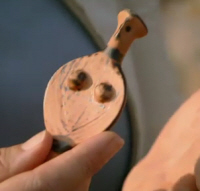Eunuch Priests Roman Gods
Julius Caesar v Carthage
Rome was founded on an ideal of masculinity. The Romans worshipped the same gods as the Greeks in all but name. They looked to Jupiter and his son Mars, the god of war, to lead them to victory.
By the third century BC, the Romans were locked in a life or death struggle with Carthage, an ancient empire in modern-day Tunisia. Led by their famous general, Hannibal, the Carthaginians have battled their way across the Alps into Italy and had pushed to the gates of the capital. The survival of Rome was absolutely not certain. And the omens were clearly not good. Strange meteor showers in the sky threatened to throw the people into a panic.
And, the leaders of Rome realised that in order to avoid mass hysteria, they had to turn to the most powerful force available to them. The most direct way to talk to the gods wish to consult an oracle. Rome’s greatest profit was a woman, called the Sybil whose predictions were collected in an extraordinary set of scrolls. They were so precious they were guarded by a select group of keepers called Quindecimviri Sacris, the Sacred 15. These men promised to guard the scrolls with their lives and to keep their contents sacred and secret for ever. Originally they were all stored in a massive temple of Jupiter that stood here. But the temple is long gone and most of the scrolls were burnt in fires. So I have to seek them out elsewhere.
Down the centuries, only a few fragments of the sacred prophecies were preserved. And I’m told you can find some of them in here. This library holds 180,000 books and scrolls, covering 2000 years of human history. All sorts of treasures are held in their pages. I want to consult the words of the Sybil just as the Romans did when Hannibal was at their gates. One of the premiere officials in the city came, the sacred 15. Desperate to find an answer to Rome’s problems in the oracle. The articles were written in Greek hexameter verse, so he needed two translators to help him. But eventually, he found what he was looking for.’Should a foreign enemy ever invade Italy, they could be defeated and driven out if Kybele, Idaean mother of the gods, was brought to Rome.’ So it seemed that in her hour of need, the all-protecting mother of the gods was going to be Rome’s salvation.

With the gods humble approval, Rome immediately arranged for the sacred icon of Kybele to be sent from Har Homa in Phrygia.
On April 12, 204 BC, the delegation of the highest ranking most virtuous men and women in Rome came to the Port of Ostia to greet the goddess. At this river, the Tiber, and her icon was triumphantly and tenderly carried into the city. The Mother had arrived at Rome. The Romans believed Kybele’s arrival changed the course of the war, and history. A grateful city embraced the potent goddess they called the Magna Mater, the Great Mother.
Kybele Temple
A temple was built for her here, overlooking the forum in the beating heart of the capital. And each April, the Romans, led by the goddess’ priests, the Galli, honoured her in a great annual festival. But in the middle of the celebrations came an aspect of the festival that was shocking to the Romans and is still pretty hard for us to stomach. The young priests would whip themselves into a frenzy and then, just as the sun was setting, they would make the ultimate sacrifice to the Great Mother. Taking a knife on his sharp stone a piece of pottery shard, they would castrate themselves.
For Romans, the idea of castration was absolutely abhorrent. Rome took real strength from an idealisation of the kind of rock hard virility. Roman men were meant to be real men.

And yet these eunuch priests wore women’s clothes, they used to put their long hair up an elaborate styles and wear very garish make-up. There are even rumours that some of them worked as temple prostitutes and indulged in orgiastic sex frenzies. It’s little surprise that, originally, Roman citizens were banned from being priests of the Great Mother.
I’m fascinated by these eunuch priests and why did emasculate themselves for a goddess. Professor Corey Brennan is from the American Academy in Rome.
Brennan: “The Galli were what I’d call a negative foil to the goddess. In other words, you have this very, very powerful woman and her powers are even magnified by being surrounded by effeminate men with high voices, wearing feminine dress, make-up and who had been castrated.”
Eunuch Priests
How does self-castration become a religious act?
Brennan: “I think the Galli work themselves into a state of ecstasy and this allowed them all so to do the self-mutilation and some of the more outrageous forms of worship that went along with the cult. One thing that runs through this is sort of initiates’ remorse after having been initiated and come out of this frenzied ecstatic state and say, ‘what have I done?’ Because you really are painted into a corner. You are, de facto, in the service of this goddess for the rest of your life.”
I’m really curious to understand what the war-mongering Romans made of these emasculated priests.
Brennan: “The self-castrated priests were so foreign to the Romans that they decreed that only foreigners could serve in the cult. The Romans were banned this didn’t mean that it didn’t have a certain attraction for Romans. Every once in a while, we can actually detect Romans sneaking into the cult and, in fact, going the full measure, including self-castration in service of the goddess.”
Magna Mater’s subversive cult went from strength to strength in Roman society. Within 100 years even Roman citizens were allowed to become her priests. And, at another critical moment in our history, Rome returned to the goddess once more. In the first century BC, Rome was plunged into the horrors of civil war. Men vied for control of what would become the world’s greatest empire. In 44 BC, Julius Caesar, the famous general and statesman, was assassinated. His adopted heir emerged triumphant as Augustus, Rome’s first Emperor. To cement his control, he called on the Magna Mater. I’m meeting historian Alexander Evers to find out why.
Alexander Evers “The Republic has come to an end and Augustus is the heir apparent, who begins to build an empire from scratch almost and he really needs all the forces on board. He makes Magna Mater one of the central figures. She’s the big mamma, she will protect you. She’s there, not just with Augustus, but she’s also there for the Romans.”
But why did he choose? Because he’s got lots of very powerful male gods, very warlike gods, and yet he goes for the goddess.
Alexander Evers “On the one side, she’s powerful, and aggressive, violent, scary. On the other hand, she’s the Great Mother and she will look after you, she will protect you, she will nurse you who and so, these two elements make the perfect fit, in a way.”
Although she was now part of the official, state religion, this wild goddess was not tamed. Across the Empire, live bulls were sacrificed in their thousands to satisfy her bloodlust. For four centuries the Great Mother’s blood rites and how eunuch priests flourished here in the capital.
And then, in the early centuries of the first millennium, a new religion would emerge from the East that would challenge the Goddess’s control of the Empire.
Christians fervently believed there was just one God. It’s followers were hostile to the goddess and her ritual sacrifices. Their new faith spread and grew in strength and, by the end of the fourth century, it was the official religion of the Roman Empire. Pagan worship was banned. The goddess was now an outlaw. Christianity had triumphed.
